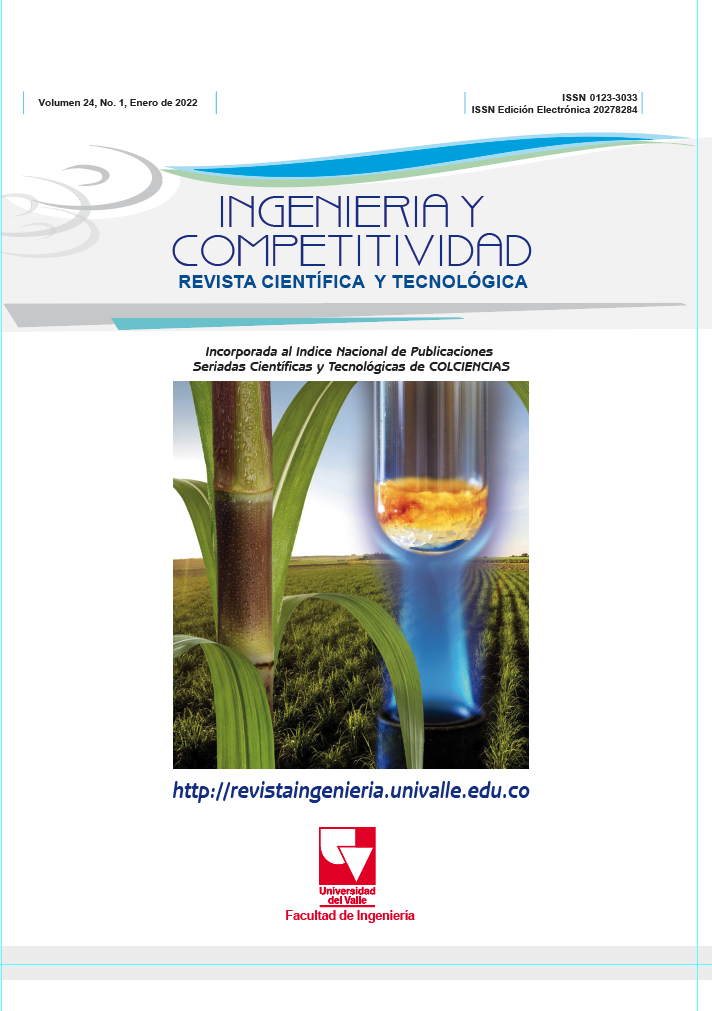Economía de vapor en el proceso de elaboración de azúcar del Ingenio Risaralda
Contenido principal del artículo
Este trabajo presenta los resultados del proyecto de investigación relacionado con la integración energética llevado a cabo en la fábrica de azúcar del Ingenio Risaralda S.A. Se muestra el desarrollo para cada una de las etapas de mejoramiento ejecutadas para reducir el vapor demandado para la elaboración de azúcar. Para alcanzar el objetivo propuesto fueron intervenidas las operaciones unitarias de calentamiento de jugo crudo, evaporación de jugo clarificado, cristalización de sacarosa y secado de azúcar húmeda. Los resultados del proyecto generaron una reducción del 19.2% en el consumo específico de vapor, pasando de 1,450 a 1,172 lbmvapor/TCM [657.6 a 531.5 kgvapor/TCM]. Igualmente, como producto de la implementación del proyecto de integración energética entre los años 2017 y 2020, se muestran los beneficios relacionados con el incremento de la venta de energía eléctrica en 3.3 GWh entregados a la red nacional.
- integración energética
- vapor de escape
- vapor vegetal
- condensado vegetal
- economía de vapor
(1) Sanz D. Análisis y Optimización exergética de una planta de Cogeneración para la Industria Azucarera [Tesis de Maestría]. Pereira: Universidad Tecnologíca de Pereira; 2014. Recuperado a partir de: http://repositorio.utp.edu.co/dspace/handle/11059/4921.
(2) Rain P. Ingenieria de la caña de azúcar. 1era ed. Bartens, editor. Berlín; 2012. 879 p.
(3) Lora EES, Rocha MH, Palacio JCE, Venturini OJ, Renó MLG, del Olmo OA. The sugar and alcohol industry in the biofuels and cogeneration era: a paradigm change (part II). Sugar Ind. 2014;139(2):97–104. https://doi.org/10.36961/si15275.
(4) De Souza-Santos ML, Chavez JV. Preliminary studies on advanced power generation based on combined cycle using a single high-pressure fluidized bed boiler and consuming sugar-cane bagasse. Fuel. 2012;95:221–225. https://doi.org/10.1016/j.fuel.2011.12.008.
(5) Amezcua-Allieri MA, Martínez-Hernández E, Anaya-Reza O, Magdaleno-Molina M, Melgarejo-Flores LA, Palmerín-Ruiz ME, et al. Techno-economic analysis and life cycle assessment for energy generation from sugarcane bagasse: Case study for a sugar mill in Mexico. Food Bioprod Process. 2019;118:281–292. https://doi.org/10.1016/j.fbp.2019.09.014.
(6) Mkwananzi T, Mandegari M, Görgens JF. Disturbance modelling through steady-state value deviations: The determination of suitable energy indicators and parameters for energy consumption monitoring in a typical sugar mill. Energy. 2019;176:211–23. https://doi.org/10.1016/j.energy.2019.03.191.
(7) Khoodaruth A. Use of Falling Thin Film Evaporator for Increasing Cogenerated Electricity in Cane Flexi-factory in Mauritius. Energy Procedia. Elsevier Ltd. 2015; 75: 1021–1026. https://doi.org/10.1016/j.egypro.2015.07.349
(8) Voigt I, Du Plessis NJ. Modular evaporators. International Sugar Journal. 2014; 116(1382):119-123.
(9) Moller D, Broadfoot S, Stephens R, Wagner S. Modification To the Evaporator Station in Preparation. In: Australia Societ of Sugar Cane Technolgists. Proc. Aust. Soc. Sugar Cane Technol. Australia: researchgate; 2003.https://doi.org/10.13140/RG.2.1.2260.7208.
Descargas

Esta obra está bajo una licencia internacional Creative Commons Atribución-NoComercial-CompartirIgual 4.0.
Los autores que publican en esta revista están de acuerdo con los siguientes términos:
Los autores ceden los derechos patrimoniales a la revista y a la Universidad del Valle sobre los manuscritos aceptados, pero podrán hacer los reusos que consideren pertinentes por motivos profesionales, educativos, académicos o científicos, de acuerdo con los términos de la licencia que otorga la revista a todos sus artículos.
Los artículos serán publicados bajo la licencia Creative Commons 4.0 BY-NC-SA (de atribución, no comercial, sin obras derivadas).


 https://orcid.org/0000-0002-1921-0484
https://orcid.org/0000-0002-1921-0484  https://orcid.org/0000-0002-8301-5464
https://orcid.org/0000-0002-8301-5464 https://orcid.org/0000-0003-4479-6699
https://orcid.org/0000-0003-4479-6699 https://orcid.org/0000-0002-0565-3532
https://orcid.org/0000-0002-0565-3532


